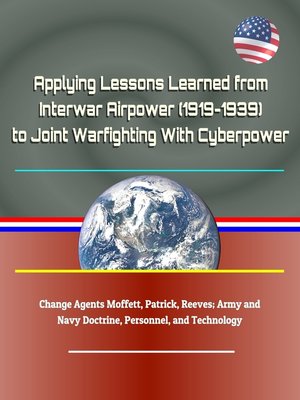Applying Lessons Learned from Interwar Airpower (1919-1939) to Joint Warfighting With Cyberpower--Change Agents Moffett, Patrick, Reeves; Army and Navy Doctrine, Personnel, and...
ebook

Sign up to save your library
With an OverDrive account, you can save your favorite libraries for at-a-glance information about availability. Find out more about OverDrive accounts.
Find this title in Libby, the library reading app by OverDrive.



Search for a digital library with this title
Title found at these libraries:
| Library Name | Distance |
|---|---|
| Loading... |
This important report has been professionally converted for accurate flowing-text e-book format reproduction. The United States has yet to use cyberwarfare in a major conflict, and the military services have differing ideas on what role cyberwarfare will play in America's next war. In addition, the services have unique and often contradictory perspectives on how they see the employment of cyberwarfare in military operations, and this conflict may affect combatant commanders' ability to employ cyberpower in their areas of responsibility. The United States military faced a similar problem after World War I when attempting to understand and exploit the nascent capabilities of airpower, which showed great potential but exited the Great War with an inconclusive service record. The Interwar Period saw rapid advancement in aviation, and the U.S. military struggled with questions of how best to organize, equip, and employ airpower after World War I's inconclusive results. The differing approaches of the United States Army and the United States Navy toward airpower evolution during the Interwar Period yield several lessons in the areas of doctrinal, personnel, and technological development that are applicable to the future employment of Joint cyberpower in the post-Afghanistan War era.
This paper first explores how the culture and biases of the Army, Army Air Corps and Navy influenced the development of Interwar airpower theory and doctrine. It then examines airpower development through the lens of personnel, and uses the concepts of the change agent and the heterogeneous engineer to show how airpower development depended on the expertise and political acumen of senior officers who believed in airpower's potential and were determined to make it a reality. Finally, it looks at how the Army Air Corps and the Navy managed uncertainty about the nature of the nation's next war while in an environment marked by rapid technological progress in aviation.
This compilation includes a reproduction of the 2019 Worldwide Threat Assessment of the U.S. Intelligence Community.







